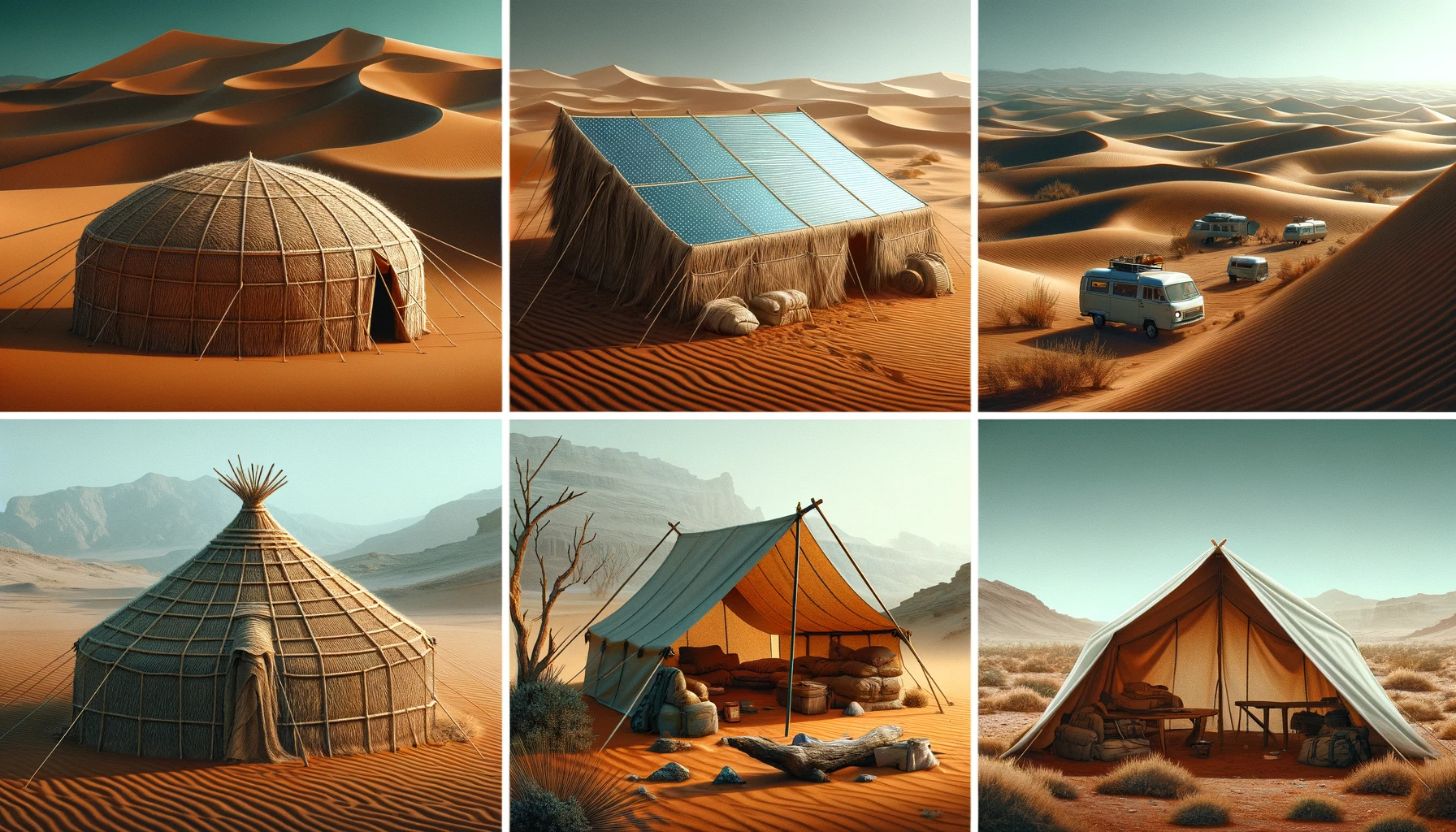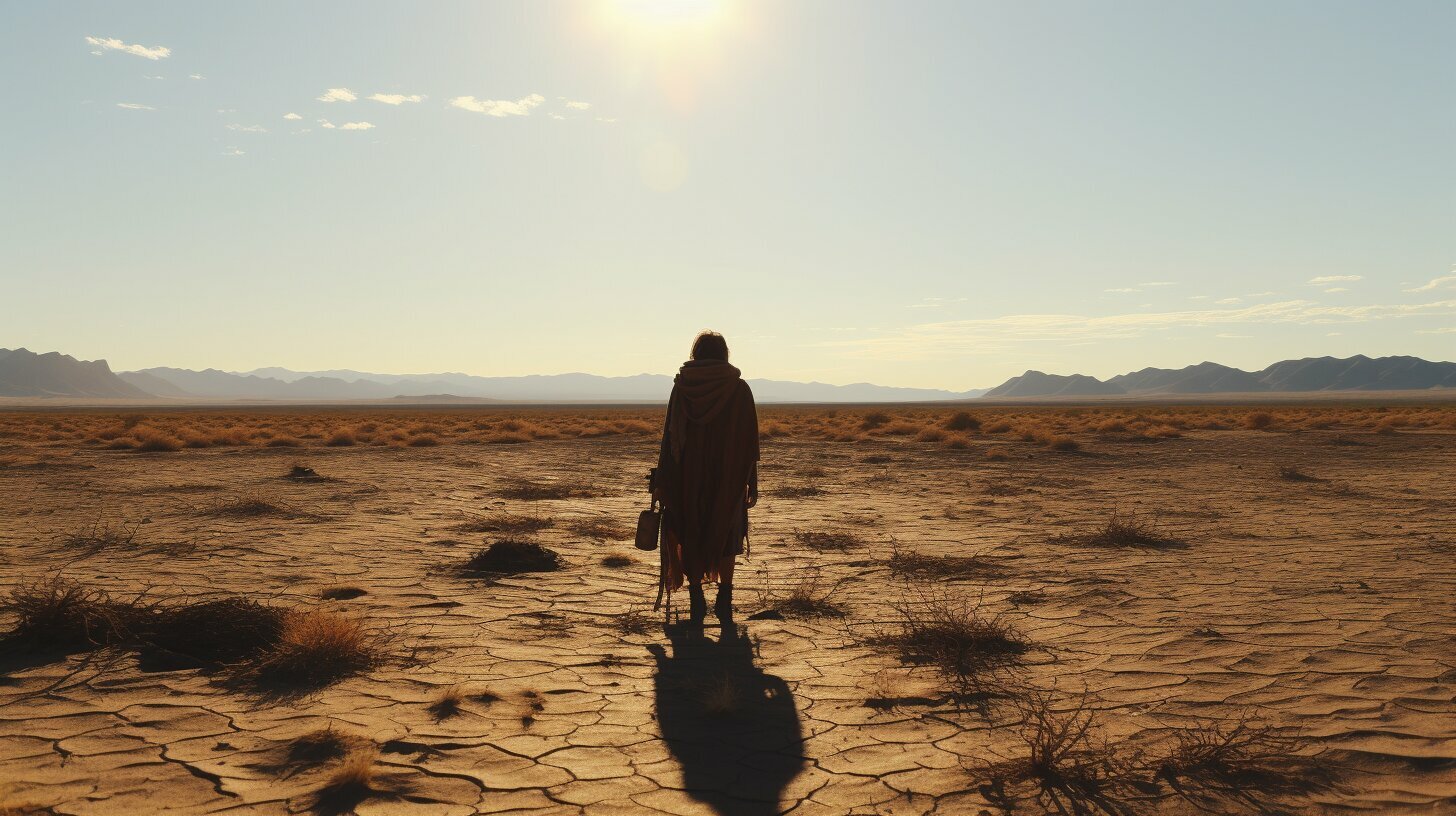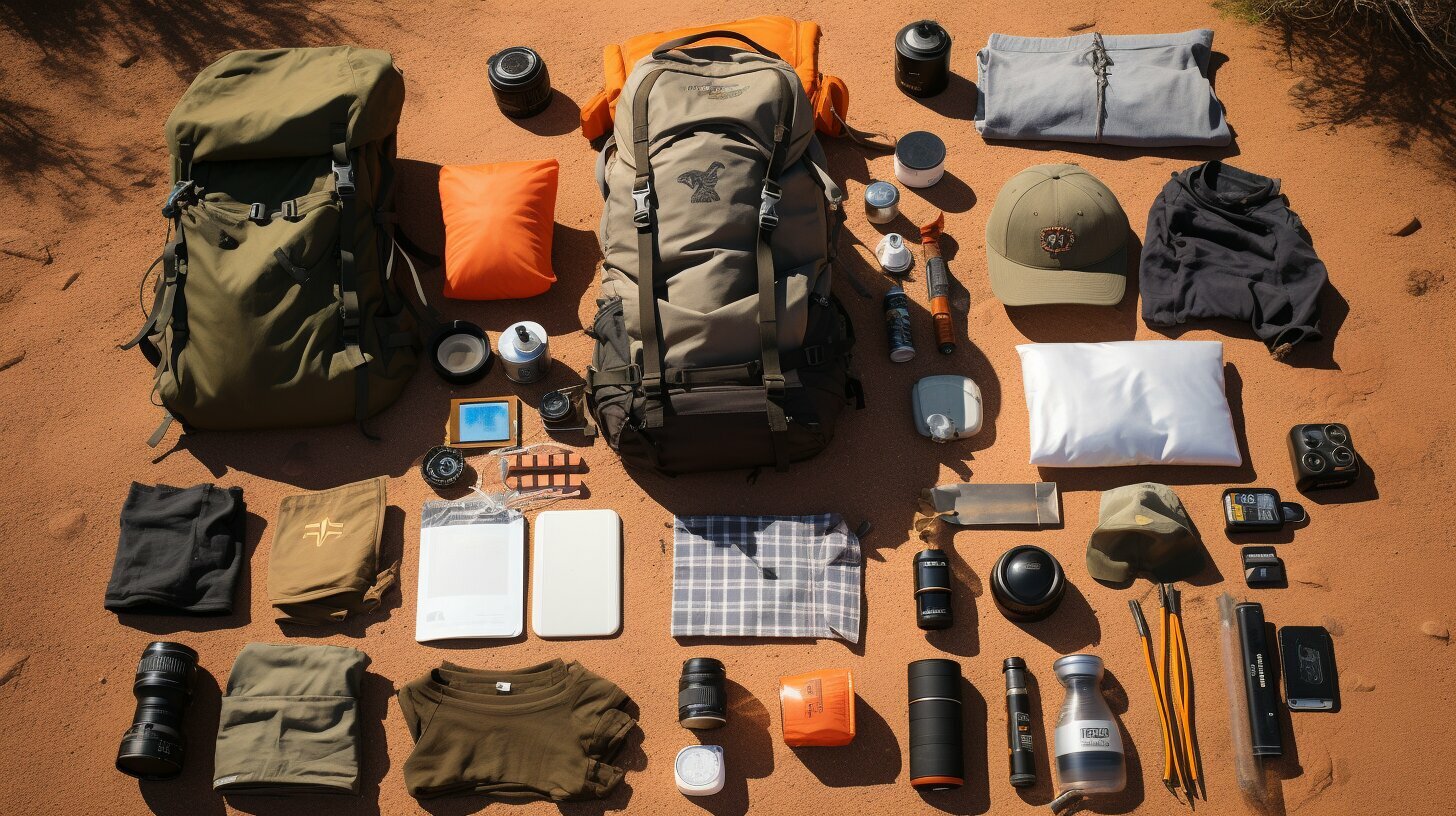In the scorching heat of the desert, finding shelter can be the difference between life and death. When exploring the vast deserts, it’s crucial to have an understanding of the different types of shelters available to you. Whether you’re planning a desert camping trip, or find yourself in an emergency survival situation, having the right type of desert shelter can make all the difference.
In this comprehensive guide, we will explore various types of desert shelters, including temporary and permanent shelters, natural shelters, and survival shelters. We’ll discuss the importance of proper shelter in the desert, and guide you through the process of selecting the best type of shelter for your particular situation.
Disclosure: When you buy through links on our site, we may earn an affiliate commission.
Key Takeaways
- Understanding the different types of desert shelters is crucial for survival and comfort in desert environments
- There are various types of desert shelters available, including temporary and permanent shelters, natural shelters, and survival shelters
- Selecting the best type of desert shelter for your particular situation is essential for your comfort and safety
- Proper preparation and maintenance of desert shelters is necessary for their longevity and effectiveness
- Surviving in the desert requires knowledge of specific techniques and shelters
Understanding the Importance of Desert Shelters
When planning a trip to the desert or finding yourself in a survival situation, having a reliable shelter is crucial. Desert environments are known for their extreme temperatures, harsh winds, and limited water sources. A well-designed desert shelter can provide protection against these elements and aid in heat regulation, ensuring your safety and well-being.
“Shelter is more important than food. You can live without food for several days, but in extreme temperatures, you need shelter to survive.” – Les Stroud, Survivorman
Efficient desert shelter designs aim to minimize heat transfer between the interior and exterior, using materials and construction techniques that create insulation and ventilation systems. Desert shelters can range from simple, improvised structures to elaborate, permanent homes. The type of shelter you choose will depend on the specific conditions of your trip or situation.
Desert Shelter Ideas
Desert camping shelters should provide protection from the elements while also being lightweight and portable. Tents, hammocks, and bivouacs are popular options for temporary shelter in the desert. They can be easily carried and set up, providing quick protection against wind, sand, and sun.
If you are planning to live in the desert long-term, permanent shelter options such as earth-sheltered homes, adobe structures, and container homes offer stability and protection against extreme heat and weather conditions. These shelter designs can be customized to integrate with the surrounding landscape, minimizing their impact on the environment and creating a comfortable living space.
Efficient Desert Shelter Designs
Efficient desert shelter designs focus on heat regulation and insulation. Materials such as insulated foam panels, adobe bricks, and stabilized soil blocks are commonly used to create thick, heat-resistant walls. Window placement and sizing also play a crucial role in creating an efficient shelter design. Windows should be strategically placed to allow natural light while minimizing heat gain.
Roof design is another important factor to consider in efficient desert shelter designs. Flat roofs with minimal slope are common, as they can support the weight of solar panels and collect rainwater. The use of reflective roofing materials can aid in heat regulation and reduce cooling costs.
Desert Camping Shelters
For short camping trips in the desert, lightweight and portable shelter options are ideal. Here are some popular options to consider:
| Shelter Type | Pros | Cons |
|---|---|---|
| Tents | Easy to set up, provides full protection from elements | Can get hot during the day, minimal insulation |
| Hammocks | Elevated off the ground, minimal footprint | No protection from rain or wind |
| Bivouacs | Can be easily constructed from natural materials | Limited protection from elements, not suitable for long-term use |
Understanding the importance of desert shelters is essential for survival and comfort in this unique environment. Whether you opt for a temporary camping shelter or a permanent desert home, selecting the right shelter type can make all the difference. When designing a desert shelter, keep efficiency, insulation, and ventilation in mind to create a safe and comfortable living space.
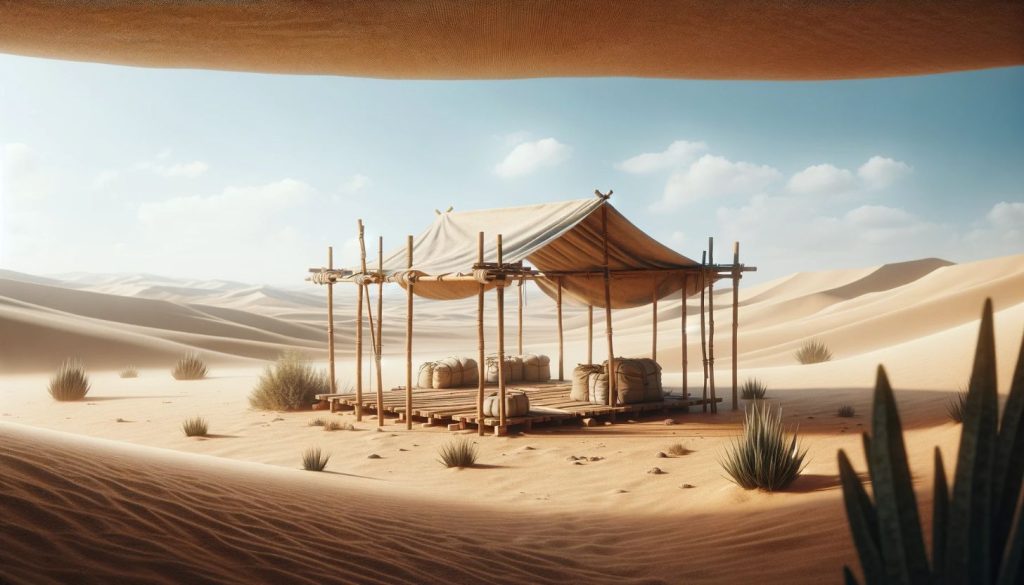
Temporary Desert Shelters
When it comes to temporary desert shelters, improvisation can be key. In an emergency situation, you may need to construct a shelter quickly using whatever materials are available to you. Before setting out on a trip, it is essential to pack lightweight, portable shelter options such as tents or hammocks.
Improvised shelters can be constructed using materials such as brush, branches, and tarps. In desert environments, sandbags can be filled with sand or dirt and stacked to create a barrier against the wind and sun. When constructing any temporary shelter, it is important to consider its location carefully. Look for areas that provide natural protection from the sun and wind, or consider erecting the shelter against a natural feature such as a rock formation or cliff face.
| Type of Shelter | Construction | Suitability for Desert Conditions |
|---|---|---|
| Improvised Shelters | Constructed using natural materials such as brush and branches, or tarps and cordage. | May not offer the greatest protection against extreme desert conditions such as high winds or sandstorms, but can provide some shade and protection from the sun. |
| Tents | Lightweight and portable, with easy-to-setup poles and rainfly. Some models are designed with UV-resistant materials and reflective coating to provide additional heat protection. | Offers better protection from the sun, wind, and sand than improvised shelters. Models with additional features such as screened windows and strong poles are more suitable for desert camping. |
| Hammocks | Lightweight and compact, with a rope or cordage for hanging between two trees or shelter anchors. Some models feature additional mosquito netting and rainfly. | Does not provide protection from the sun or wind, but can keep the body elevated off the hot desert ground. |
When constructing a temporary desert shelter, it is essential to consider the surrounding environment and weather conditions. Always have a backup plan and pack extra shelter materials in case of emergency.
Permanent Desert Shelters
When it comes to long-term residency in the desert, permanent shelters offer stability and protection. The key to building an efficient desert shelter is to select designs that can withstand extreme temperatures, strong winds, and limited water sources. Here are some permanent shelter options worth considering:
Earth-Sheltered Homes
Earth-sheltered homes are a great choice for those seeking a sustainable, eco-friendly, and energy-efficient living solution. These homes are built into desert slopes, offering natural insulation and protection against the elements, reducing the need for heating and cooling systems. They can be designed with skylights, windows, and ventilation systems to provide ample natural light and fresh air.
Some of the materials used for construction include concrete, adobe, or rammed earth. The construction process requires extensive planning and excavation, which can be time-consuming and labor-intensive. However, the end result is a durable, long-lasting shelter that blends into the desert landscape.
Adobe Structures
Adobe structures, made from clay-rich soil and straw, have been used for centuries as permanent shelters in desert regions. The adobe walls provide excellent insulation, keeping the interior cool during the day and warm at night. They are cost-effective, energy-efficient, and can be easily constructed with readily available materials.
It’s important to note that adobe structures require regular maintenance, as they are susceptible to erosion and cracking. However, with proper upkeep, they can provide a durable and sustainable living solution.
Container Homes
Container homes are an innovative and sustainable solution for permanent desert living. These homes are constructed from recycled shipping containers, which are designed to withstand extreme weather conditions and can be customized to fit any specific housing needs.
Container homes can be equipped with energy-efficient features such as solar panels, rainwater harvesting systems, and gray water recovery systems. They can also be designed to blend into the desert landscape and offer a comfortable and sustainable living space.
| Pros | Cons |
|---|---|
| Cost-effective and eco-friendly | The construction process can be time-consuming and costly |
| Highly customizable | May require additional insulation for extreme temperatures |
| Durable and weather-resistant | May require permits and zoning approvals for construction |
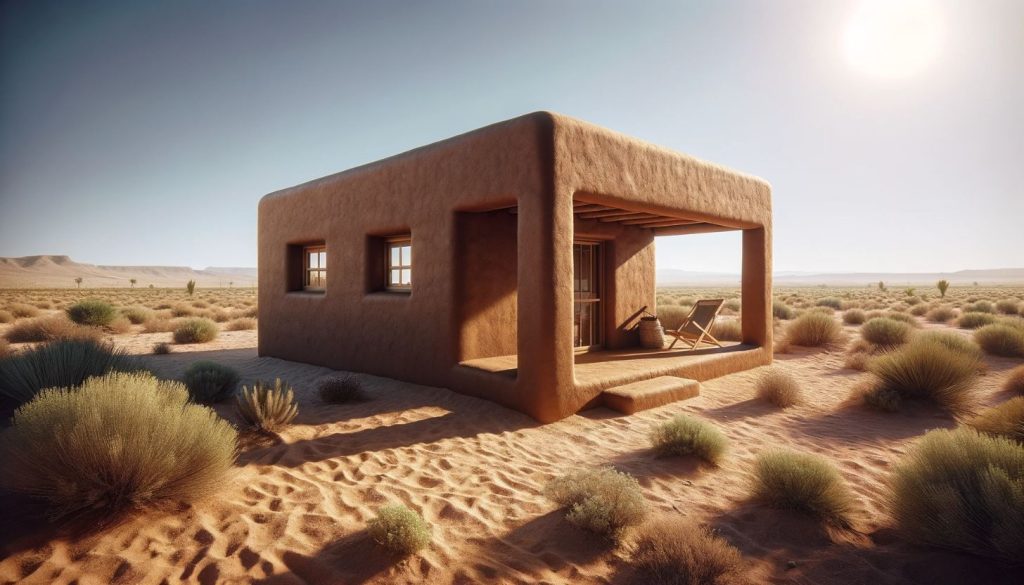
When selecting a permanent desert shelter, it’s important to consider the specific requirements for your living situation. Factors such as budget, climate, and sustainability goals should be carefully evaluated to determine the best option for your needs. With proper planning and construction, a permanent desert shelter can provide a secure, comfortable, and sustainable living space in the harsh desert environment.
Natural Desert Shelters
When exploring the desert, it’s essential to know that nature can provide shelter options for emergency situations.
Caves
Caves are one of the most well-known natural shelters in the desert. They provide a dry environment and insulation against extreme temperatures. However, it’s important to note that not all caves are safe for sheltering. Make sure to check for signs of animal activity or potential rockfalls before entering.
Rock Formations
Rock formations can provide natural shelter, as they can create shade and block wind. Look for rock formations with an overhang or a hollow to provide protection. However, be cautious of crevices and sharp edges before settling in for the night.
Overhangs
Overhangs are formed by a protruding rock layer that provides coverage overhead. They can offer protection against the sun and wind, making them ideal for temporary shelter. However, keep in mind that overhangs can be unpredictable in size and stability, so make sure to assess them before choosing to use them as a shelter.
Desert Trees
Desert trees like the Joshua tree provide natural shelter from the sun, making them a good option for temporary shade. However, be aware that some trees have thorns or needles that may make them uncomfortable to lean against or sleep under.
Modifying Natural Shelters
It’s important to understand that natural shelters may require some modifications to be suitable for longer stays. For example, rocks can be used to build walls around the shelter to block wind and sand, and branches can be used to create a roof. Use materials that are available in the environment to make the shelter more effective.
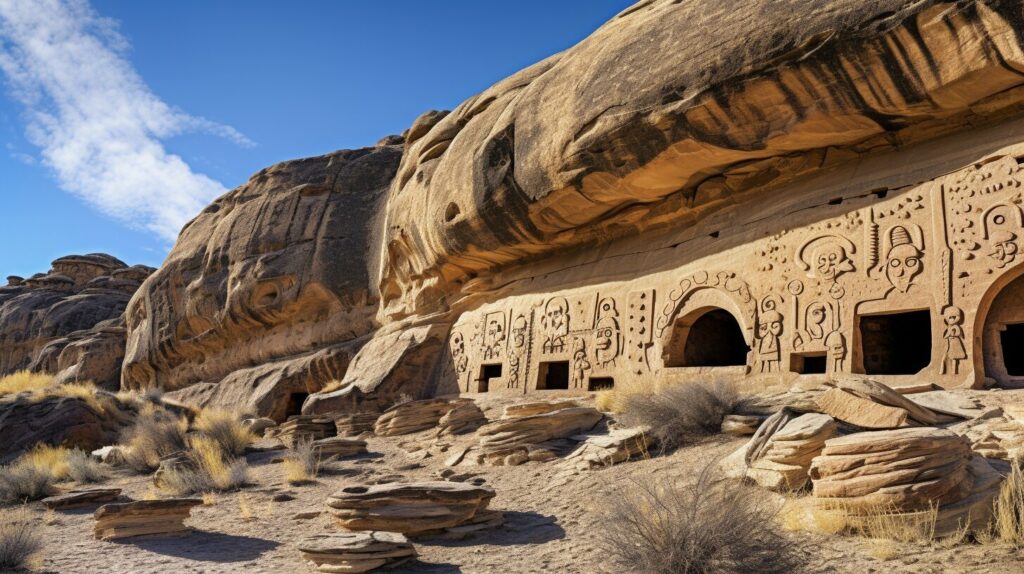
Always prepare for the possibility of having to build a shelter from scratch.
Desert Survival Techniques and Shelters
Surviving in the desert can be challenging, but having the right knowledge and tools can make all the difference. When it comes to shelter, understanding the different types of shelters available and how to construct them is essential. Here, we will explore some of the best desert shelters for survival and how to use them.
Sandbag Shelters
During a desert survival situation, sandbags can be used to build a sturdy shelter. Start by filling sandbags with sand or desert debris and stack them in a circular shape, leaving space in the middle for an entrance. Cover the sandbags with a tarp or other waterproof material to provide protection from the elements. Reinforce the shelter with additional sandbags around the outside to provide stability.
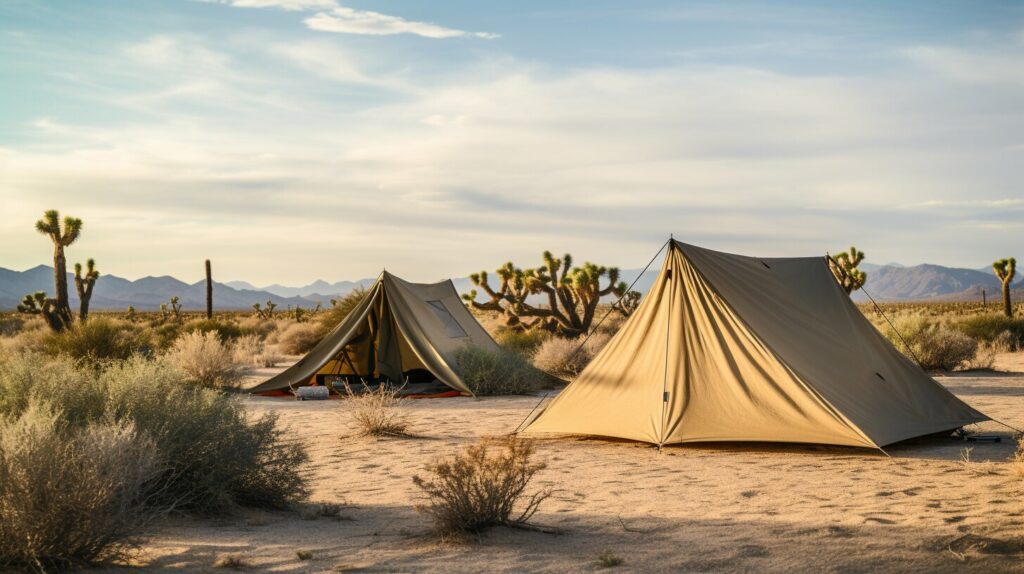
Solar Stills
In a desert environment, water is scarce and must be conserved. A solar still is an effective way to collect water from the desert air. To construct a solar still, dig a hole in the ground and place a container in the middle. Put a piece of plastic over the hole and use rocks or dirt to weigh down the edges, leaving a slight depression over the container. The sun will evaporate water from the soil, and the plastic will capture the condensation, allowing it to drip into the container.
Reflective Tarp Shelters
A reflective tarp is an excellent option for desert shelters during the day. Use a lightweight, reflective material to create a triangular shelter. Set up the tarp by attaching one end to a sturdy pole or tree and securing the bottom corners with stakes. The reflective material will help to deflect the sun’s heat and keep the shelter cooler.
Comparison Table of Desert Survival Shelters
| Shelter Type | Pros | Cons |
|---|---|---|
| Sandbag Shelter | Durable and sturdy, protection from elements | Requires significant effort to construct, heavy to transport |
| Solar Still | Effectively collects water, low-maintenance | Requires digging and a container to collect water |
| Reflective Tarp Shelter | Easy to set up, deflects heat to keep shelter cool | Does not provide protection from the elements at night |
When it comes to choosing the best desert shelter for survival, consider your specific situation and the conditions of the environment. Proper preparation, knowledge, and tools are crucial for your survival in the harsh desert climate. With the right shelter and survival techniques, you can increase your chances of staying safe and secure in the desert.
Preparing for Desert Shelter Construction
When it comes to constructing a desert shelter, proper planning and preparation are key to success. A poorly constructed shelter can leave you exposed to the harsh desert elements, jeopardizing your safety and well-being. Here are some essential tips to help you prepare for desert shelter construction:
Choose a suitable location
The first step in constructing a desert shelter is finding a suitable location. Look for an area that is level, dry, and offers some natural protection from the wind and sun. Avoid low-lying areas that may flood during rainstorms.
Gather necessary materials
Next, you’ll need to gather the necessary materials for constructing your shelter. Depending on the type of shelter you plan to build, you may need items such as tarps, poles, cordage, and rocks. Take inventory of the materials you have on hand and make a list of what you need to acquire.
Consider available resources
When constructing a desert shelter, it’s important to consider the resources that are available to you in the surrounding area. For example, if rocks are abundant, consider building a rock shelter. If you have access to a tarp or tent, you can use that as the basic structure for your shelter.
Test the stability of your shelter
Before settling in for the night, make sure to test the stability of your shelter. Ensure that it can withstand strong winds and is properly anchored to the ground. This will prevent your shelter from collapsing or blowing away in the middle of the night.
Optimize your shelter for comfort
While your desert shelter should prioritize functionality and safety, you can also take steps to optimize it for comfort. Bring along a sleeping pad or cot to elevate yourself off the ground, and consider using a reflective tarp to deflect heat and provide additional insulation.
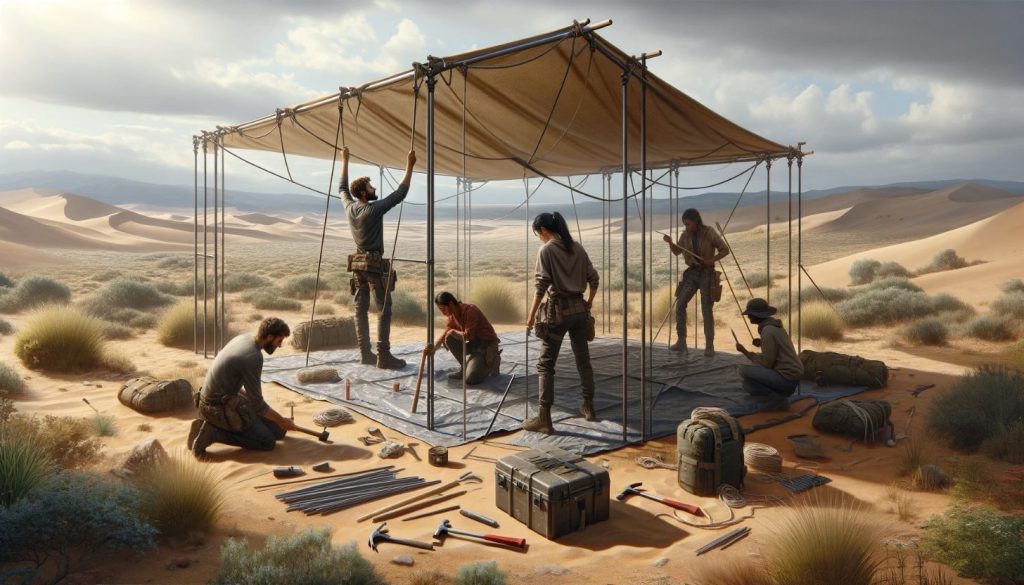
By following these tips and taking the time to properly plan and prepare, you can construct a desert shelter that will keep you safe and comfortable in even the harshest desert environments. Remember to always prioritize safety and functionality over aesthetics or comfort.
Tips for Desert Shelter Maintenance and Upkeep
After constructing your desert shelter, it’s important to prioritize its maintenance to ensure its longevity and effectiveness in protecting you from the harsh desert environment. Here are some valuable tips to help you maintain and repair your shelter:
- Regular cleaning: Keeping your shelter clean and free of debris will prevent damage and prolong its lifespan. Sweep or vacuum the floors, and dust off any surfaces regularly.
- Checking for damages: Regularly inspect your shelter for any damages. Check for cracks, holes, and leaks, and repair them immediately to prevent further damage.
- Proper ventilation: Adequate ventilation is essential in desert shelters to prevent excess moisture buildup and mold growth. Install vents or windows to promote airflow.
- UV protection: The harsh UV rays in the desert sun can cause damage to your shelter’s materials, leading to deterioration and weakening. Apply UV-protective coatings or paints to your shelter to prolong its lifespan.
- Upgrading insulation: Proper insulation is crucial for regulating the temperature inside your shelter. Consider upgrading your shelter’s insulation with materials such as foam or fiberglass to improve heat retention and prevent excessive cooling.
Example of a Maintenance Checklist:
| Task | Recommended Frequency |
|---|---|
| Clean floors and surfaces | Weekly |
| Check for damages and repairs | Monthly |
| Replace damaged materials | As needed |
| Check for proper ventilation | Monthly |
| Apply UV-protective coatings or paints | Annually |
| Upgrade insulation materials | As needed |
By following these maintenance tips and periodic checks, you can ensure your shelter stays in top condition, protecting you from the harsh desert environment for years to come.
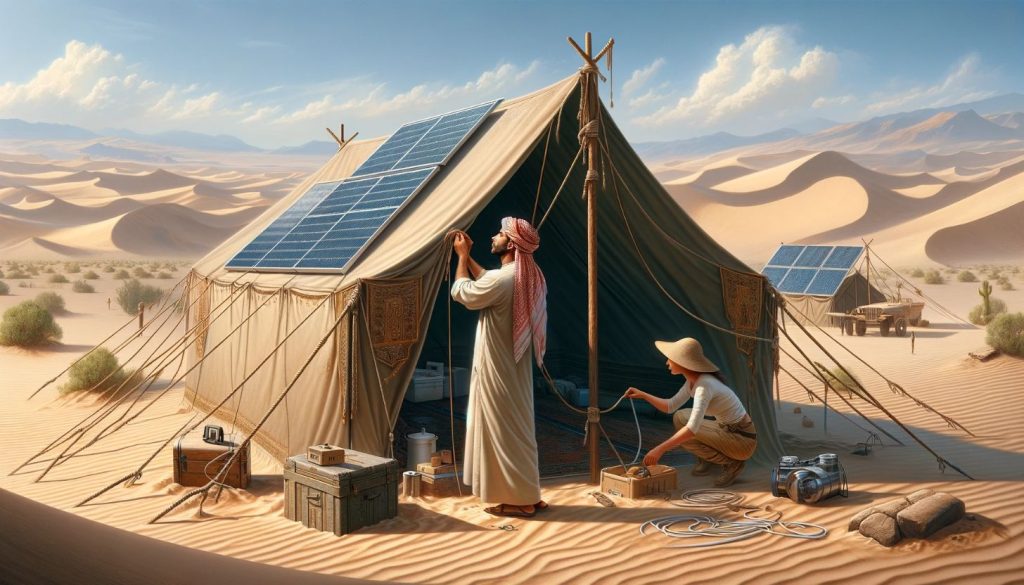
Conclusion
Understanding and selecting the right type of desert shelter is a crucial aspect of desert exploration and survival. From the various options available, including temporary and permanent structures, to the importance of selecting the most appropriate shelter for your specific situation, this guide has covered the essentials.
It’s clear that a well-chosen and properly maintained desert shelter is not just a matter of comfort, but a critical component for safety and survival in the harsh and unforgiving desert environment. Whether you are planning a brief camping trip or a longer stay in the desert, remembering these insights and applying them will significantly enhance your desert experience, ensuring that you are well-prepared to face the unique challenges of desert living.
FAQ
What are the different types of desert shelters?
The different types of desert shelters include temporary shelters such as improvised shelters, tents, and hammocks, as well as permanent shelters like earth-sheltered homes, adobe structures, and container homes. Natural desert shelters such as caves, rock formations, and overhangs can also be used.
Why is having a shelter in the desert important?
Having a shelter in the desert is important because desert environments have extreme temperatures, harsh winds, and limited water sources. A well-designed desert shelter can provide protection against these elements and aid in heat regulation, ensuring your safety and well-being.
What are some natural desert shelters?
Natural desert shelters include caves, rock formations, and overhangs. These features can be utilized as shelters in the desert, but may require modifications for suitability and proper usage.
What are some temporary desert shelters?
Temporary desert shelters include improvised shelters, tents, and hammocks. These shelters are often used in survival situations or during short stays in the desert and offer portability and ease of construction.
What are some permanent desert shelters?
Permanent desert shelters include earth-sheltered homes, adobe structures, and container homes. These shelters offer stability and protection for those planning to live in the desert long-term.
What are some desert survival shelters?
Desert survival shelters are specifically designed for survival scenarios in desert environments. Some options include sandbag shelters, solar stills, and reflective tarp shelters.
How do I prepare for desert shelter construction?
To prepare for desert shelter construction, you should select suitable locations, gather necessary materials, and utilize available resources. Proper preparation is key to the stability and functionality of your desert shelter.
How do I maintain and upkeep a desert shelter?
To maintain and upkeep a desert shelter, you should follow proper maintenance techniques, which may include regular inspections, repairs, and protection from the harsh desert environment. This ensures the longevity and effectiveness of your shelter.
Why is it important to choose the right desert shelter type?
Choosing the right desert shelter type is important because it provides protection and comfort in desert environments. Consider the specific conditions and requirements of your desert adventure or living situation to select the most suitable shelter for your needs.

